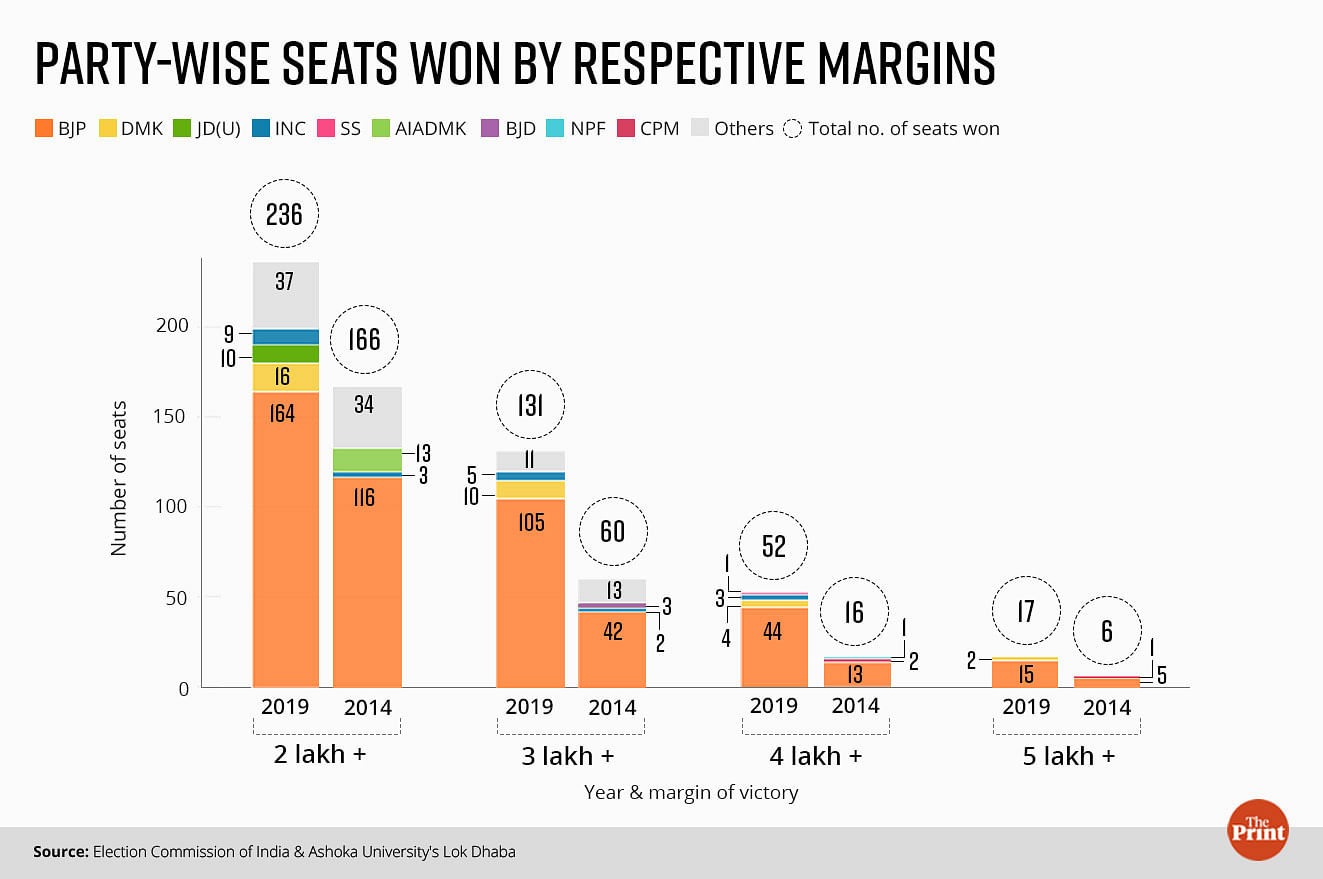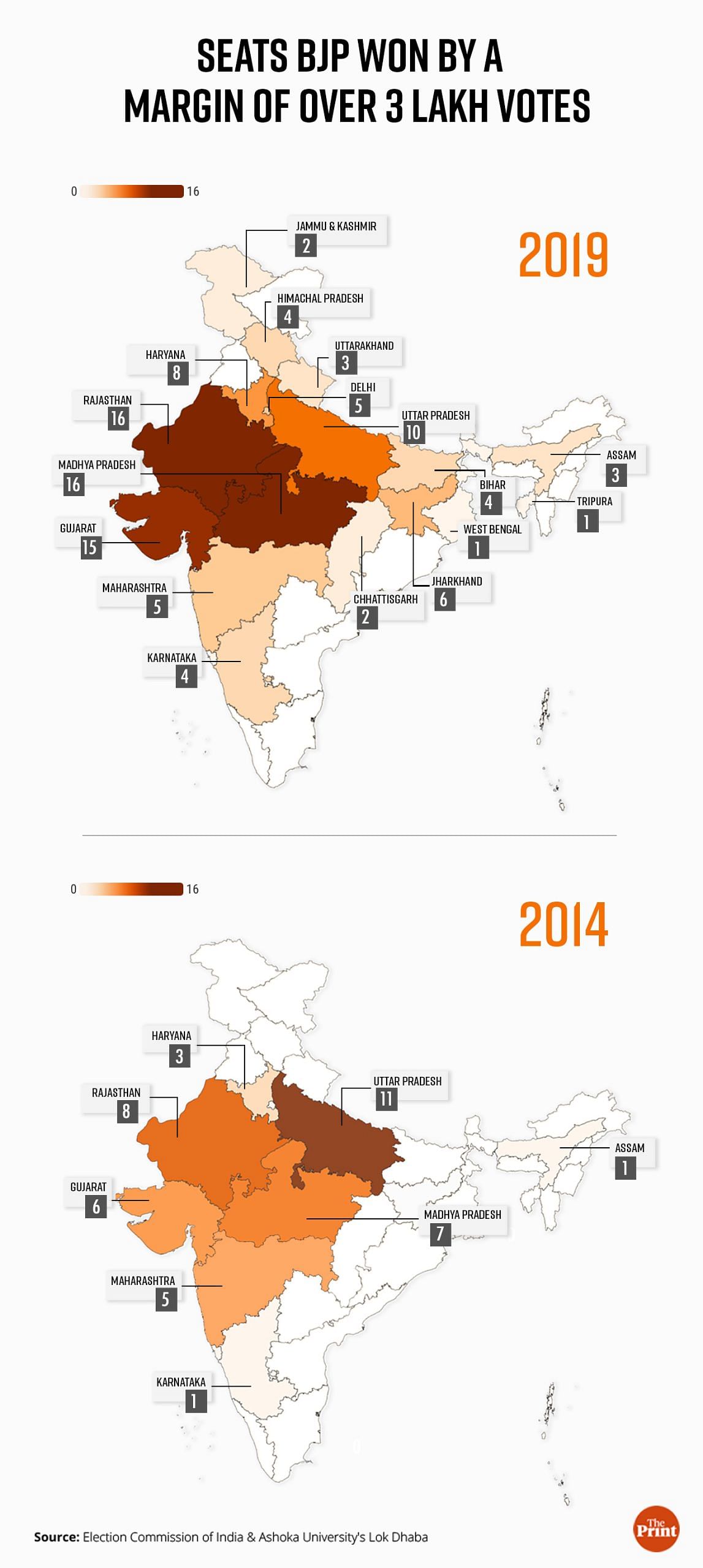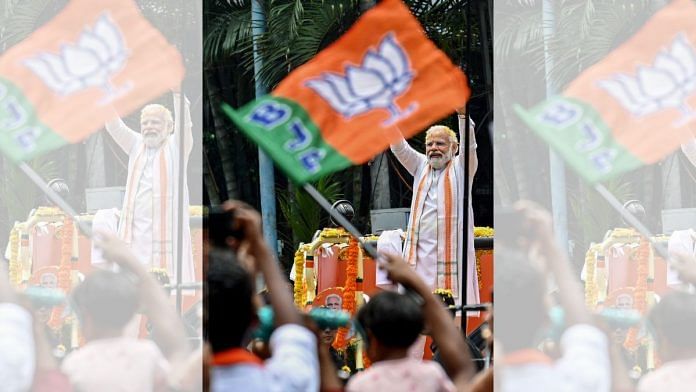New Delhi: In the 2019 Lok Sabha polls, the ruling Bharatiya Janata Party (BJP) won in 105 seats by a margin of over 3 lakh votes — 63 seats more than in 2014 — indicating the sheer size of the challenge Opposition parties are likely to face in the 2024 general elections. On 23 June, 18 Opposition parties are scheduled to meet in Patna to try and develop a unified strategy to defeat the BJP in the forthcoming elections.
ThePrint analysed the victory margins of candidates in the 2014 and 2019 elections.
Of the 236 candidates who won by a margin of over 2 lakhs votes in 2019, 164 were from the BJP. Of the 131 who won by a margin of over three lakh votes, 105 were from the BJP — the remaining 26 included 10 from the Dravida Munnetra Kazhagam (DMK) and five from the Congress, among others.
BJP candidates won 44 seats with over 4 lakh votes, and 15 with over 5 lakh votes.
“Vote share of the nearest competitor (Congress) remained the same in 2019 as in 2014. But the vote share of the BJP went up. So, you expect more BJP MPs to win by a larger margin (in 2024). One would also expect more candidates in different states to win by bigger margins,” said Sanjay Kumar, professor and co-director of Lokniti, a research programme at the Centre for the Study of Developing Societies (CSDS), to ThePrint.
“From a macro perspective, 31 per cent (vote share) going up to 37 per cent, number of seats going up from 282 to 303 is an indication that the victory is more convincing,” he added.
On the significance of victory margins, Kumar said: “If 100 BJP MPs are elected by a narrow margin, then there is an indication that the party is not on a very strong wicket. It could lose a large number of seats because the party has won a large number of marginal seats. Marginal seats are an indication of the party’s support base. If you are winning 105 seats with a margin of 3 lakh votes, one can say that the party will safely win these seats again because the victory margin has been very large. Over 3 lakh votes is a very big margin.”
A major chunk of the seats the BJP won by such a vast margin came from the states it had swept in both 2014 and 2019. In fact, the party’s victory margins have only grown in these states.

For instance, the BJP swept Rajasthan, winning all 25 seats in both elections, with one seat won by its ally Rashtriya Loktantrik Party in 2019. Eight of these seats in 2014 were won by a margin of over 3 lakh votes, which doubled in 2019.
The BJP has also maintained its dominance in Prime Minister Narendra Modi’s home state — Gujarat — winning all 26 Lok Sabha seats in the past two general elections. However, the seats won by a margin of over 3 lakh votes, have more than doubled from six in 2014 to 15 in 2019.
Other three states that the BJP swept in 2014 and 2019 — Delhi, Uttarakhand and Himachal Pradesh — weren’t won by a margin of over 3 lakhs. However, in the latest general elections, all but four seats in these states, were won by a margin of over 3 lakhs.
Speaking to ThePrint, columnist and political analyst, Rasheed Kidwai said that victory margins play a very significant role in “establishing supremacy”, and explain the rise in the BJP’s vote percentage. “BJP seats have not increased in proportion to increase in vote share. That explains the bigger margins, or the ‘Modi hawa’. But a rise in vote share does not necessarily mean a rise in seats,” said Kidwai.
He also believes that in the states where BJP had a clean sweep, Congress has become weaker.
Talking to ThePrint about its analysis, the BJP national spokesperson, R.P. Singh said, “Our party works continuously. We have been preparing for 2024 for the past two years. We have identified the seats and states as well. People on behalf of the government or the party are continuously visiting such places. It is very difficult to beat this overall political machinery.”
Commenting on the low number of seats the Opposition won by over 3 Lakh votes, Singh said that’s because they don’t have an agenda and make “fake promises”. “Rahul Gandhi had promised that in 10 days farm loans will be waived in Rajasthan but they have not delivered…. If you don’t have a good policy people don’t vote for you. To implement these policies also, they need a credible face.”
However, Kumar believed that these victory margins shouldn’t worry the Opposition excessively.
“BJP’s performance in 2014 and 2019 does not give us any indication of what is likely to happen in 2024. There is no indication of that. This should not concern (the Opposition) because every election is different, issues may be different. Alliance patterns may be different. There are other things that should worry the Opposition,” he said.
“What, though, should worry the opposition is that a divided opposition cannot pose a challenge to the BJP (in 2024 polls),” he added.
Also read: Ahead of 2024 LS polls, why BJP has picked Sunil Bansal to be its point person in UP once again
‘Modi magic’
The BJP, in 2019, not only won more seats by a margin of over 3 lakh votes, it has also spread its influence. From mere eight states — where its MPs registered a victory by over 3 lakh votes — the number of states with such victory margins have more than doubled to 17.
According to Kidwai, the “Modi magic” played a big role in this.
“People were essentially voting against the Congress or for Narendra Modi in many places”, said Kidwai. “Modi magic absolutely became stronger in 2019. There was the Balakot strike and people voted with vengeance. Congress had won Madhya Pradesh and Rajasthan (in assembly polls). However, in Lok Sabha, they lost all seats in Rajasthan and won one seat in Madhya Pradesh by a very thin margin.”

In 2019, of all of BJP’s candidates, Gujarat party president C.R. Patil won from his Navsari seat by the biggest margin of over 6.89 lakh votes. Apart from Patil, three other candidates won by over 6.1 lakh votes — the entire population of Sikkim.
In Haryana, the BJP’s Sanjay Bhatia won by 6.56 lakh votes and party’s Krishan Pal by 6.38 lakh votes. In Rajasthan, BJP MP Subhash Chandra Baheria won by 6.12 lakh votes. In the Opposition camp, DMK’s P. Velusamy won by the highest victory margin of over 5.38 lakh votes.
Analysis of past data ‘futile’
Opposition parties, however, feel that 2019 polls were different and that big margins won’t necessarily impact the 2024 Lok Sabha polls.
Speaking to ThePrint, Praveen Chakravarty, Chairman of Congress’s Data Analytics department, said, “Analysis of past data is futile beyond a certain point”.
“Why is a 3-lakh margin significant? I look at vote share. Greater than 40 per cent is an important benchmark. The BJP has certainly increased its number of seats with more than 50 per cent vote share from 2014 to 2019, but all these past data analyses is futile beyond a certain point. If past data was such a big factor in electoral performance, BJP’s 2014 performance would be completely unexplainable,” he said. “As they say in financial markets, past performance is not an indicator of future returns.”
Akhilesh Yadav’s Samajwadi party (SP) is an important participating member in the 23 June opposition meet, which will also include the Congress, Janata Dal (United), Trinamool Congress (TMC) and DMK.
At present, SP is the Opposition’s best bet in Uttar Pradesh — which accounts for 80 MPs.
Speaking about the victory margins, party spokesperson Ghanshyam Tiwari said, “These victory margins would mean something if they are for leaders of consequence.”
“The mood of the nation (in 2014 and 2019) was on a certain agenda and people voted for that agenda. Where candidates appear to be lamp posts on display at the pleasure of the prime minister…that is not a victory margin that represents electoral power. When a candidate wins on the strength of its own candidature, that is the victory margin that represents the strength of electoral power,” he added.
According to Tiwari, the 2024 polls should not be based on the 2014 and 2019 elections. “2024 will have its own agenda,” he said. “When BJP does not have an agenda to present, it stuns the people by some agenda that is not in public consciousness, so we will see what is the stunner that BJP pulls out. People are also mentally prepared for what the party, which builds its electoral fortunes on tragedies, will come up with in 2024. People are waiting.”
Former Lok Sabha MP and TMC national spokesperson Kirti Azad said that in 2019, circumstances were different due to the Pulwama attack. He added that this time around, people have become more “intelligent”. “They know that the BJP’s campaign is based on empty promises and use of religious deities for political gain. Like they tried to use ‘Bajrang Bali’ in Karnataka’.”
(Edited by Zinnia Ray Chaudhuri)
Also read: If Lok Sabha elections go assembly polls way, BJP could lose 17 of 25 MPs in Karnataka



